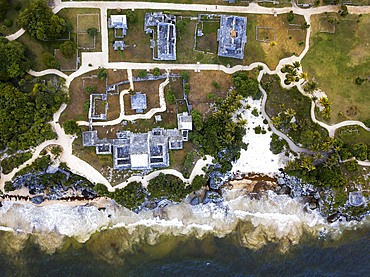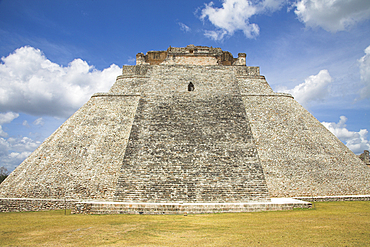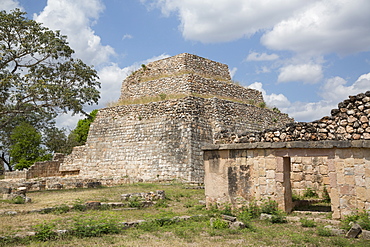Recent searches
Loading...
1350-6597 - Aerial views of El Castillo and the Ruins of the Mayan temple grounds at Tulum, Quintana Roo, Yucatan, Mexico. Tulum is the site of a pre-Columbian Mayan walled city which served as a major port for Coba, in the Mexican state of Quintana Roo. The ruins are situated on 12 meter 39 ft tall cliffs along the east coast of the Yucatán Peninsula on the Caribbean Sea in the state of Quintana Roo, Mexico. Tulum was one of the last cities built and inhabited by the Maya; it was at its height between the 13th and 15th centuries and managed to survive about 70 years after the Spanish began occupying Mexico. Old World diseases brought by the Spanish settlers appear to have resulted in very high fatalities, disrupting the society, and eventually causing the city to be abandoned.
1350-6599 - Aerial views of El Castillo and the Ruins of the Mayan temple grounds at Tulum, Quintana Roo, Yucatan, Mexico. Tulum is the site of a pre-Columbian Mayan walled city which served as a major port for Coba, in the Mexican state of Quintana Roo. The ruins are situated on 12 meter 39 ft tall cliffs along the east coast of the Yucatán Peninsula on the Caribbean Sea in the state of Quintana Roo, Mexico. Tulum was one of the last cities built and inhabited by the Maya; it was at its height between the 13th and 15th centuries and managed to survive about 70 years after the Spanish began occupying Mexico. Old World diseases brought by the Spanish settlers appear to have resulted in very high fatalities, disrupting the society, and eventually causing the city to be abandoned.
1350-6596 - Estructura 8I-13 El Castillo at Chunyaxche Muyil Maya ruins, rainforest near Tulum, Yucatan Peninsula, Quintana Roo, Mexico
1350-4702 - Group of the Thousand Columns, Chichen Itza Archaeological Site, Chichen Itza, Yucatan State, Mexico
1350-4845 - Piramide del Adivino, Pyramid of the Magician, Uxmal Archaeological Site, Uxmal, Yucatan State, Mexico
1350-5005 - El Castillo, Pyramid of Kukulkan, Chichen Itza Archaeological Site, Chichen Itza, Yucatan State, Mexico
1350-4923 - El Castillo, Pyramid of Kukulkan, Chichen Itza Archaeological Site, Chichen Itza, Yucatan State, Mexico
1350-4692 - El Palacio, The Palace, Kabah Archaeological Site, Kabah, near Uxmal, Yucatan State, Mexico
1350-4822 - Piramide del Adivino, Pyramid of the Magician, Uxmal Archaeological Site, Uxmal, Yucatan State, Mexico
1116-50880 - Dream catchers for sale; Bonampak, Usumacinta Province, Chiapas, Mexico
1350-3791 - Shrine of El Maximon in Santiago De Atitlan, Guatemala. Maximon saint/devil is one of the strongest remnants of the Mayan faith
1350-3770 - Mayan women baking tortillas in the streets of Antigua, Guatemala, Central America. La Tortolita.
1350-3751 - Holy Week processions in Guatemala city. Holy Thursday. Holy Week in Guatemala is celebrated with street expressions of faith, called processions, usually organized by a "hermandades". Each procession of Holy Week has processional floats and steps, which are often religious images of the Passion of Christ, or Marian images, although there are exceptions, like the allegorical steps of saints.
1350-3777 - Chichicastenango, Quiche, Guatemala, Central America. Processions of Festival of Santo Thomas. On Easter Sunday The Comrades (Council Men) Carry The Andas (Floats) Of The Saints In Procession From The Santo Tomas
1350-3780 - Portrait of a man in traditional dress remain in one of the streets of Chichicastenango, Guatemala.
1350-3778 - Chichicastenango, Quiche, Guatemala, Central America. Typical women hats during Holy Week processions.
1350-3753 - Holy Week processions in Guatemala city. Holy Thursday. Comparsa. Holy Week in Guatemala is celebrated with street expressions of faith, called processions, usually organized by a "hermandades". Each procession of Holy Week has processional floats and steps, which are often religious images of the Passion of Christ, or Marian images, although there are exceptions, like the allegorical steps of saints.
1350-3775 - Chichicastenango, Quiche, Guatemala, Central America. Processions of Festival of Santo Thomas. On Easter Sunday The Comrades (Council Men) Carry The Andas (Floats) Of The Saints In Procession From The Santo Tomas
832-389144 - Mayan temple in the rainforest, ancient Mayan city, Tikal National Park, Guatemala, Central America
801-2483 - Structure 17, Ek Balam, Yucatec-Mayan Archaeological Site, Yucatan, Mexico, North America
801-2482 - Structure 17, Ek Balam, Yucatec-Mayan Archaeological Site, Yucatan, Mexico, North America
801-2484 - Structure 1 with Covered Stucco Facade, The Acroplolis, Ek Balam, Yucatec-Mayan Archaeological Site, Yucatan, Mexico, North America
801-2481 - Entrance Arch, Ek Balam, Yucatec-Mayan Archaeological Site, Yucatan, Mexico, North America
801-2485 - Oval Palace, Ek Balam, Yucatec-Mayan Archaeological Site, Yucatan, Mexico, North America
801-2486 - Oval Palace, Ek Balam, Yucatec-Mayan Archaeological Site, Yucatan, Mexico, North America
1297-149 - The Great Plaza, part of the Copan Ruins, a Mayan archaeological site, UNESCO World Heritage Site, Copan, Honduras, Central America
1297-143 - The screaming Macaw on Ball Court in Copan Ruins, UNESCO World Heritage Site, Copan, Honduras, Central America
1297-142 - The face on Stelae B in Copan Ruins, UNESCO World Heritage Site, Copan, Honduras, Central America
1297-148 - The Stelae P carving at Copan Ruins, UNESCO World Heritage Site, Copan, Honduras, Central America
1297-145 - Temple 22 in East Court in Copan Ruins, UNESCO World Heritage Site, Copan, Honduras, Central America
1297-146 - A face carving of Pauahtun in East Court at the Copan Ruins, UNESCO World Heritage Site, Copan, Honduras, Central America
1297-144 - Ball Court, in the archaeological site of the Maya civilization, at Copan Ruins UNESCO World Heritage Site, Copan, Honduras, Central America
1297-147 - A carved face on a wall from Structure 29 in the Copan Ruins, UNESCO World Heritage Site, Copan, Honduras, Central America
801-2318 - Serpent Head, Temple of Warriors, Mayan Ruins, Mayapan Archaeological Site, Yucatan, Mexico, North America
801-2317 - Observatory in foreground), Kukulcan Castle in background, Mayan Ruins, Mayapan Archaeological Site, Yucatan, Mexico, North America
801-2308 - Mirador Temple Pyramid, Labna Archaeological Site, Mayan Ruins, Puuc style, Yucatan, Mexico, North America
801-2310 - Chac Rain God Stone Mask, Palace, Xlapak Archaeological Site, Mayan Ruins, Puuc style, Yucatan, Mexico, North America
801-2309 - Arch (Arco), Labna Archaeological Site, Mayan Ruins, Puuc style, Yucatan, Mexico, North America
801-2311 - Chac Rain God Stone Mask, Palace, Xlapak Archaeological Site, Mayan Ruins, Puuc style, Yucatan, Mexico, North America
801-2307 - Serpent Mouth, with Human Mask, Palace, Labna Archaeological Site, Mayan Ruins, Puuc style, Yucatan, Mexico, North America
801-2312 - Northwest Temple, Mayan Ruins, Mayapan Archaeological Site, Yucatan, Mexico, North America
801-2315 - Temple of Warriors in the foreground, Painted Niches Temple in the background, Mayan Ruins, Mayapan Archaeological Site, Yucatan, Mexico, North America
801-2316 - Serpent Head, Temple of Warriors, Mayan Ruins, Mayapan Archaeological Site, Yucatan, Mexico, North America
801-2314 - Chac Complex in the foreground, Observatory in the background, Mayan Ruins, Mayapan Archaeological Site, Yucatan, Mexico
801-2306 - Chac Rain God Mask, Palace, Labna Archaeological Site, Mayan Ruins, Puuc style, Yucatan, Mexico, North America
801-2313 - Stucco reliefs, Castle of Kukulcan, Mayan Ruins, Mayapan Archaeological Site, Yucatan, Mexico, North America
801-2305 - Palace, Labna Archaeological Site, Mayan Ruins, Puuc style, Yucatan, Mexico, North America
801-2302 - Stone Figure, Palace of the Masks (Codz Poop), Kabah Archaeological Site, Mayan Ruins, Puuc style, Yucatan, Mexico, North America
801-2304 - Carved Stones, Kabah Archaeological Site, Mayan Ruins, Puuc style, Yucatan, Mexico, North America
801-2303 - Palace of the Masks (Codz Poop), Kabah Archaeological Site, Mayan Ruins, Puuc style, Yucatan, Mexico, North America
801-2301 - Palace (Teocalli), Kabah Archaeological Site, Mayan Ruins, Puuc style, Yucatan, Mexico, North America
801-2300 - Palace (Teocalli), Kabah Archaeological Site, Mayan Ruins, Puuc style, Yucatan, Mexico, North America
801-2291 - Palace of Stuccos, Mayan Archaeological Site, 300 AD to 900 AD, Acanceh, Yucatan, Mexico, North America
801-2290 - Structure of the Seven Dolls, Mayan Ruins, Dzibilchaltun Archaeological Site, 700 to 800 AD, near Merida, Yucatan, Mexico, North America
801-2289 - Structure of the Seven Dolls, Mayan Ruins, Dzibilchaltun Archaeological Site, 700 to 800 AD, near Merida, Yucatan, Mexico, North America
801-2288 - Structure 36, Mayan Ruins, Dzibilchaltun Archaeological Site, 700 to 800 AD, near Merida, Yucatan, Mexico, North America
801-2262 - Mayan Ruins, Structure CA-4, Oxkintok Archaeological Zone, 300 to 1050 AD, Yucatan, Mexico, North America
801-2266 - Mayan Ruins, Structure MA-9 in background, Oxkintok Archaeological Zone, 300 to 1050 AD, Yucatan, Mexico, North America
801-2261 - Mayan Ruins, Structure CA-4, Oxkintok Archaeological Zone, 300 to 1050 AD, Yucatan, Mexico, North America
801-2267 - Mayan Ruins, Oxkintok Archaeological Zone, 300 to1050 AD, Yucatan, Mexico, North America
801-2260 - Mayan Ruins, Northern Arch, Oxkintok Archaeological Zone, 300 to 1050 AD, Yucatan, Mexico, North America
801-2264 - Mayan Ruins, The Palace with Statues, Oxkintok Archaeological Zone, 300 to 1050 AD, Yucatan, Mexico, North America
801-2263 - Mayan Ruins, The Palace, Statue, Oxkintok Archaeological Zone, 300 to 1050 AD, Yucatan, Mexico, North America
801-2265 - Mayan Ruins, Structure of the Canul Group, Oxkintok Archaeological Zone, 300 to 1050 AD, Yucatan, Mexico, North America
801-2258 - Mayan Ruins, Ball Court, Chacmultun Archaeological Zone, Chacmultan, Yucatan, Mexico, North America
801-2256 - Mayan Ruins, The Palace, Puuc Style, Chacmultun Archaeological Zone, Chacmultan, Yucatan, Mexico, North America
801-2255 - Mayan Ruins, Cabapak Group, Puuc Style, Chacmultun Archaeological Zone, Chacmultan, Yucatan, Mexico, North America
801-2259 - Mayan Ruins, The Palace, Puuc Style, Chacmultun Archaeological Zone, Chacmultan, Yucatan, Mexico, North America
801-2257 - Mayan Ruins, The Palace, Puuc Style, Chacmultun Archaeological Zone, Chacmultan, Yucatan, Mexico, North America
857-94735 - A Mayan Jaguar dancer performs at a cultural ceremony at Blue Creek Village, Toledo, Belize
1218-522 - Tulum ruins, Yucatan, Quintana Roo, Mexico, North America
1218-521 - Tulum ruins, Yucatan, Quintana Roo, Mexico, North America
483-2010 - Tikal temple 1, Pre-Columbian Maya civilisation, Tikal, UNESCO World Heritage Site, Guatemala, Central America
483-2013 - Tikal Temple 5, pre-Colombian Maya civilisation, Tikal, UNESCO World Heritage Site, Guatemala, Central America
1218-378 - Group of people hold hands at the summit of Nohoch Mul Pyramid in the Ancient Mayan City of Coba, outside Tulum, Mexico, North America
1218-379 - Pyramid in the Ancient Mayan ruins of Coba, outside of Tulum, Mexico, North America
809-6815 - Temple I (Temple of the Giant Jaguar) at Tikal, UNESCO World Heritage Site, Guatemala, Central America
809-6816 - Temple I (Temple of the Giant Jaguar) at Tikal, UNESCO World Heritage Site, Guatemala, Central America
1218-120 - Night portrait of Pyramid at Tikal, UNESCO World Heritage Site, Guatemala, Central America
801-1803 - Stucco Mask, The Mask Temple, Lamanai Mayan Site, Belize, Central America
801-1810 - Stucco Frieze, Castillo, Xunantunich Mayan Ruins, outside San Ignacio, Belize, Central America
801-1804 - Stucco Mask, The Mask Temple, Lamanai Mayan Site, Belize, Central America
801-1808 - Castillo, Xunantunich Mayan Ruins, near San Ignacio, Belize, Central America
801-1805 - Stucco mask (lower left), The High Temple, Lamanai Mayan Site, Belize, Central America
801-1811 - Castillo, Xunantunich Mayan Ruins, outside San Ignacio, Belize, Central America
801-1809 - Stucco Frieze, Castillo, Xunantunich Mayan Ruins, outside San Ignacio, Belize, Central America
801-1806 - Mayan Arch, entry to Plaza A, Cahal Pech Mayan Ruins, San Ignacio, Belize, Central America
1199-301 - El Castillo at Tulum, Yucatan, Mexico, North America
801-1583 - Structure 1, Calakmul Mayan Archaeological Site, UNESCO World Heritage Site, Campeche, Mexico, North America
801-1582 - Stelae in front of Structure 1, Calakmul Mayan Archaeological Site, UNESCO World Heritage Site, Campeche, Mexico, North America
801-1584 - Structure 3, Early Classic Period, Calakmul Mayan Archaeological Site, UNESCO World Heritage Site, Campeche, Mexico, North America
801-1580 - Stela 24 on right, and Stela 23 on left, on top of Structure VI, Calakmul Mayan Archaeological Site, UNESCO World Heritage Site, Campeche, Mexico, North America
801-1581 - Stelae in front of Structure 2, Calakmul Mayan Archaeological Site, UNESCO World Heritage Site, Campeche, Mexico, North America
801-1562 - Palace of the Governor, Uxmal, Mayan archaeological site, UNESCO World Heritage Site, Yucatan, Mexico, North America
801-1564 - Palace of the Governor, Uxmal, Mayan archaeological site, UNESCO World Heritage Site, Yucatan, Mexico, North America
801-1568 - House of Turtles, Uxmal Mayan archaeological site, UNESCO World Heritage Site, Yucatan, Mexico, North America
801-1559 - Double-headed Jaguar, Palace of the Governor, Uxmal, Mayan archaeological site, UNESCO World Heritage Site, Yucatan, Mexico, North America
801-1567 - Columns Building in foreground with Pyramid of the Magician beyond, Uxmal, Mayan archaeological site, UNESCO World Heritage Site, Yucatan, Mexico, North America
801-1569 - Pyramid of the Magician, Uxmal, Mayan archaeological site, UNESCO World Heritage Site, Yucatan, Mexico, North America
801-1560 - Palace of the Governor on left, with Pyramid of the Magician in the background, Uxmal, Mayan archaeological site, UNESCO World Heritage Site, Yucatan, Mexico, North America



































































































